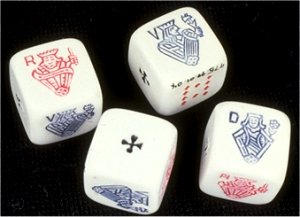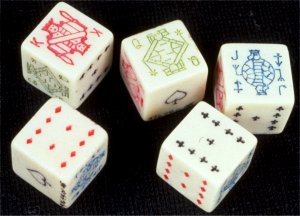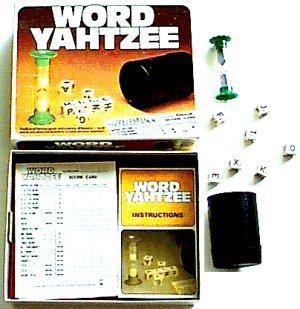
The game of Yahtzee has many antecedents, some of which are in the collection. As one can see in the photograph on the right, the game makes use of "Anglo-Norman" cubical dice, with standard numbering.
According to the Sierra Corporation, the game of Yahtzee is based upon an old tavern dice game know as Yacht. The photograph at the right is a partial set of European Poker Dice donated to the Museum in 1975. Each die is 1.7cm square with rounded corners. One of the set of 5 is missing. The maker is unknown.
The die on the extreme left is a "king" - the "R" standing for the French word for king "roi". Next to this die is the "jack" or "V" for "valet". The lower right is the "queen" or "D" for "dame". On the other sides showing are one of the "clubs" suit and the 10 of the "diamonds" suit.
These dice have been common in a number of European countries, and it has been reported that people play games with them while traveling on trains or in taverns. One observer indicated that these dice are often used by friends to decided who will pay for a meal or a drink!

The photograph at the left is a similar set of Poker Dice that were made in the United States or England before 1940. They were donated to the Museum in 1983.
A bar and tavern game played with these dice in English speaking countries is sometimes called Liar Dice. (See D. Pritchard, The Family Book of Games, Sceptre Books, 1994, page 173.) It too is primarily a game of poker using dice, however the difference is that a dice cup is used to shake the dice. When the dice are rolled onto a table, the player doesn't reveal them to the other players but keeps them covered by the dice cup. The player carefully looks under the dice cup and calls out a poker hand, keeping the dice covered. The covered dice with the cup is moved to the next player who either accepts the "hand" as "called", or challenges it. If accepted, the next player picks up the dice and tries to beat the hand as "called". If challenged - the dice cup is picked up and the dice are exposed. The game continues in this manner. Pritchard offers additional instructions and details in the manner of play.

The photograph on the left is the box of the original game of Yahtzee, issued by E.S. Lowe in 1956. The Museum does not have a copy of this original game, but does have other versions which are described on this page. Along with the original game, Lowe also marketed a box of Yahtzee Score Pads which could be purchased to supplement the game. As the box top illustrates - the game requires the use of five "Anglo-Norman" dice.
In 1979, the Museum purchased it's first desktop computer. This was before the era of an IBM PC. The computer was a Z80 Compucolor and it was delivered with a number of games on floppy 8 inch cardboard discs. One of these games was Yahtzee . Unfortunately, we no longer have a way to obtain a photograph of the game that was generated on the screen. The software for the game was written in an early form of BASIC, and the graphics drawn were inherent to the Z80 processor. Two persons could play. Play was via the keyboard. As the game progressed, the screen display changed. A player's score appeared in white. A table of random numbers were used by the software in the play of the game. This was before desktop computers had sound or a mouse. To find our more about this computer and the cardboard discs, click on the left menu item above.

The photograph on the right is a "screen capture" of the 1999 Sierra, Inc. CD game of Yacht, which is one of the games in Sierra's Hoyle Board Games for play on a computer. This is a microcomputer version of Yahtzee.
It should be noted that play of the game using the 5 dice requires each player (2 or 4) to roll the dice up to 3 times during each turn. The player may decide to stop at any roll, and record the best score on the dice, i.e. - "2 2s" or "2 4s" in the photograph. Note that the score pad includes "4 of a kind", "Full House", "5 Straight", etc. These are all terms used in the playing card game of Poker. It may be inferred, that this game may have originally been a way to play Poker without using playing cards, but now uses the standard "Anglo-Norman" cubical dice instead. Thus, it appears that the game of Yahtzee evolved or was developed from the game of Poker Dice.

In 1963, E. S. Lowe marketed a new game called Scribbage (click on "Word Games" in the left menu above for information about Scribbage). It was a "dice" game, but instead of standard dice markings, each side of a die contained a letter. The intent of this game was similar to other "dice-word" games of the period - to make words from the letters that came up when the dice were rolled.
Then about 1978, Milton Bradley Co. (which had absorbed E.S. Lowe) marketed a new version of Yahtzee, called Word Yahtzee. The copy in the photograph at the left was donated to the Museum in 1987. This new version of Yahtzee combined elements from the original game of Yahtzee and the game of Scribbage.
Each imprinted side of a die in Word Yahtzee included an alphabetical letter and a numeric value. A one-minute timer and score pads formed part of the package.
Last update March 5, 2010